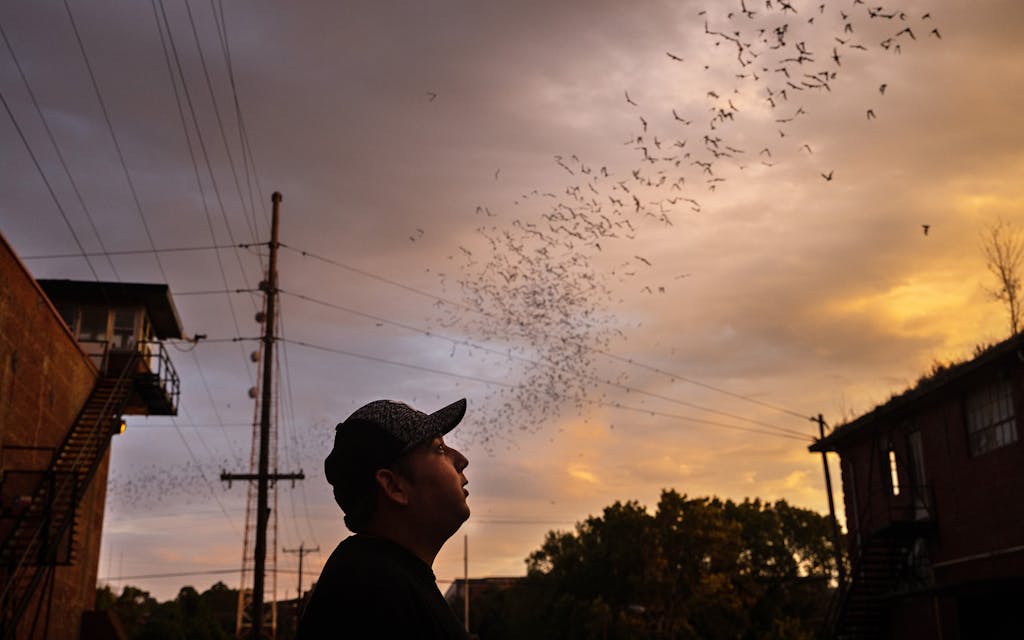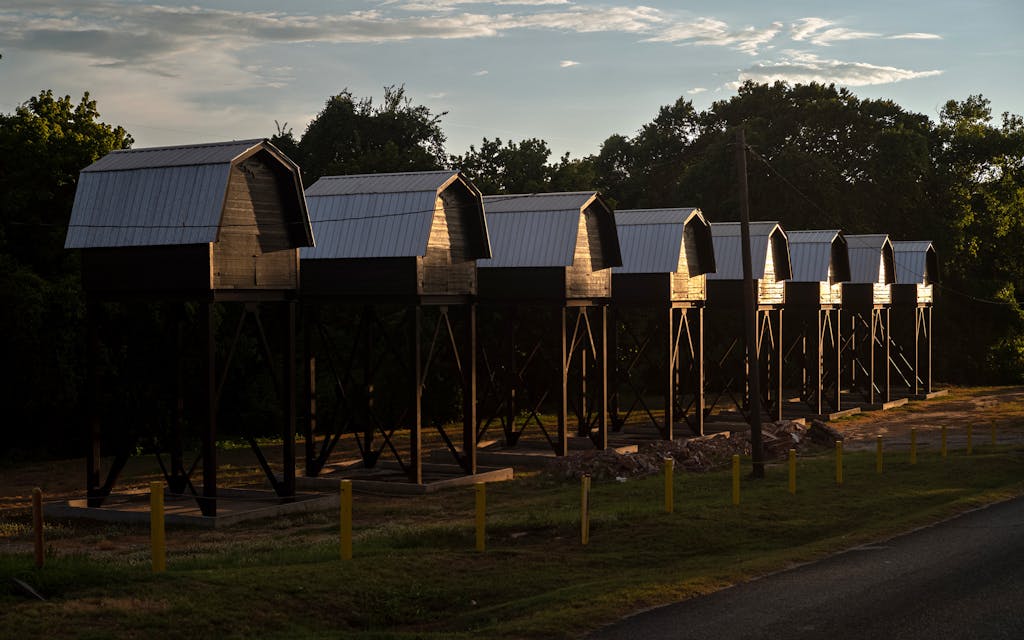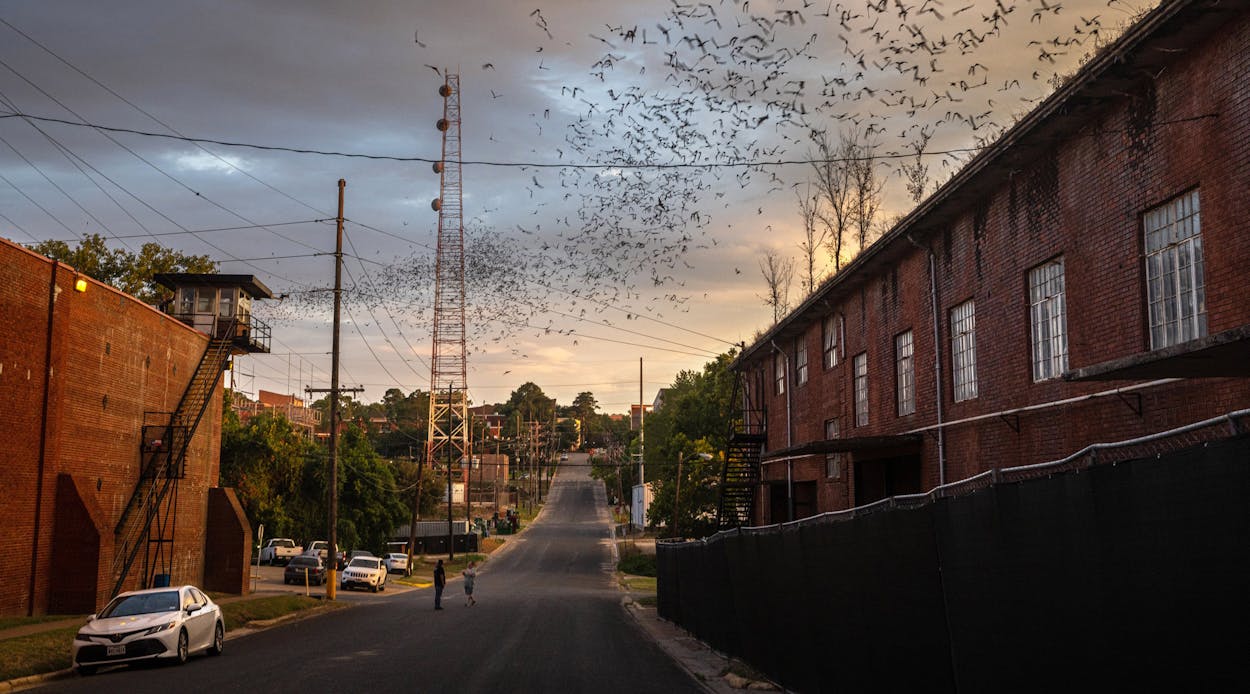Many a tourist attraction fails to live up to the hype surrounding it, but that’s never the case when bats are involved. Stand in the crowd at one of the bat-friendly bridges in Austin or Houston, or drive a half hour northeast of San Antonio to Bracken Cave—the summer home of more than 15 million Mexican free-tailed bats, the largest bat colony in the world—and you’ll inevitably be awed as the winged critters take to the skies for their nighttime hunt. They pour out of their roosts with such grandeur that the scientific term for the event is an “emergence.” They appear not as a collection of individual creatures—with those leathery wings, hooked thumbs, and adorably big ears—but as a cohesive mass, like an expensive, complicated visual effect out of a Marvel movie. The experience is even more surreal if, rather than watching them beside a cavern or a river crossing, you’re right next door to the most infamous prison in the state.
The beauty of an emergence is one reason the citizens of Huntsville, an hour north of downtown Houston, are trying to save the bat colony that roosts in an abandoned storage building next door to the Walls Unit, the local nickname for the Texas State Penitentiary, which squats right in the middle of town. The warehouse takes up half a city block and was originally built in the thirties to house cotton and other dry goods harvested and produced by prisoners. It’s a decrepit carcass of a building, with dead trees rising out of its crumbling roof. It’s an eyesore, but one that is occasionally stunning thanks to the roughly 750,000 Mexican free-tailed bats that spend their summers there, streaming out of the broken windows every night at dusk.
The bats attract both locals and tourists, who park their cars next to the fifteen-foot-tall redbrick barricades that give the Walls Unit its name. The bats emerge to a soundtrack that could only be heard in Huntsville: the hum of hundreds of thousands of flapping wings mingles with the roar of the siren indicating it’s time to count the prisoners. Families set up camping chairs a stone’s throw from the building where the state conducts all its executions (the most in the country since 1982, and more than those in the next six states combined). It’s a strange pairing—nature’s majesty hand in hand with the depravity of man—and it could all go away if the Texas Department of Criminal Justice ever gets to tear that warehouse down, which it has been trying to do for a decade.

The TDCJ has long said the warehouse is hazardous and that it must be safely demolished before it falls apart on its own. Phase one of demolition has already begun; in March of this year, construction workers knocked down the northernmost third of the warehouse before pausing the following month, when the bats returned on their annual migration. The state intended to finish demolition once the bats left again in the fall.
But what the TDCJ may not have anticipated is the growing contingent of impassioned locals determined to keep that from happening. “I’ve lived around this area all my life, and I’ve never seen anything in our town draw people together quite like this issue,” says Tommy Hoke, one of the locals leading the charge. Hoke, a salesman who attends the Baptist church next to the warehouse, was always aware of the bats, but he became a self-described bat nerd only after he saw that demolition on the warehouse had begun. The more Hoke read about the bats—like how their insect-focused diet saves Walker County farmers an estimated $3 million in annual pesticide costs—the more certain he was about their value to the community, and the more concerned he was about their future.
“But I was apprehensive,” he admits. “I’m just a regular guy; I’m not a biologist. What can I do?” He took his concerns to Facebook, starting a page called “Help! Save the Bats in Huntsville!!” His first post was shared more than nine hundred times, and his group is currently the larger of the two pro-bat Facebook groups in town, with more than 1,800 members.


The other group is helmed by Daiquiri Beebe, a Huntsville City Council member and real estate agent. The Huntsville Bat Society now has more than 1,400 members and started a Change.org petition to let the prison know some citizens of Huntsville wanted the bats to stay (to date, more than 1,200 have signed). Beebe tried to get the city council to pass a resolution opposing the TDCJ’s plans, but when it didn’t generate the votes needed, she kept at it, planning pro-bat happy hours and protests near the county courthouse.
As public support grew, Beebe was able to enlist other local government officials in the cause, including state representatives Ernest Bailes and Kyle Kacal, who in turn recruited members of the Walker County Commissioners’ Court. By July, those on the city council who had voted against Beebe’s earlier resolution started to come around. “We had the public, the city council, and the county commissioners all saying, ‘We have to stop this. We can’t let them tear the warehouse down,’ ” Beebe recalls. In mid-July, the TDCJ agreed to halt demolition until 2023.
TDCJ has been trying to solve this problem for years. Mexican free-tailed bats, our state’s official flying mammal, are protected by law. Though the warehouse is on TDCJ property, Texas Parks and Wildlife can fine TDCJ if demolition results in unnecessary loss of bat life, and TPWD intervened when prison officials first began discussing plans to demolish the building in 2012.
Years later, the prison took note of the University of Florida’s success in expelling bats from its football stadium, an effort spearheaded by Merlin Tuttle, an Austin conservationist known as Texas’s “Bat Man.” TDCJ officials, who didn’t consult with Tuttle, had Huntsville inmates construct artificial bat roosts, or “bat hotels,” meant to lure the colony out of the warehouse over a period of years. But the expert-provided blueprints weren’t properly followed, resulting in black bat houses that were scorching in the Texas heat. In the four years since they were erected next to the warehouse, the structures, which Hoke and others refer to as “bat ovens,” have attracted few bats. The prison has done little to make them more bat-friendly.

Spokespeople for both the TDCJ and TPWD insist that the decision to begin demolition earlier this year was not made lightly. The hope was that, by tearing down the building in stages, the agencies would encourage the bats to finally move to the artificial roosts, a plan a TDCJ representative says is “based on recommendations from experts in the field.” The agency has only now agreed to pause that plan “to ensure community members and advocates are engaged in the discussion.”
There’s a rumor around town that the prison tried to board up the warehouse one night while the bats were out, in hopes that they’d take shelter in the bat hotels, but instead the bats went to the warden’s house down the street and crapped all over his cars. A prison representative adamantly denies this. But if something were to happen to the warehouse, either by planned demolition or disaster, it could be calamitous for the Huntsville community. Bats returning during their springtime migration would likely roost under nearby roof shingles and carports or in stadiums across town, according to Nathan Fuller, a bat expert at TPWD. This would likely increase interactions between humans and bats, which would be fine if we were talking about just a couple dozen bats, rather than hundreds of thousands of newly homeless ones.
Now that the TDCJ has given conservationists a bit more time, the real work begins. Earlier this summer, when the pro-bat Facebook groups gained traction, the TDCJ set up a steering committee to explore solutions to the bat problem, with representatives from the prison, the city, and TPWD. In September, they set up a subcommittee charged with bringing specific recommendations by the end of the year.
“We’re coming around to three alternatives,” says Russell Humphrey, one of the five members of the subcommittee. Humphrey, a city council member also serving as deputy mayor, jokes that he’s become a “batologist” in the past few months (the scientific term is “chiropterologist”). One proposed fix: a conservation-minded group takes ownership of the warehouse (either through purchase or donation), though that would require costly renovations to the decaying structure. Restoring the building may not be a plausible long-term solution anyway. The TPWD chiropterologist Fuller, another member of the subcommittee, says the warehouse isn’t currently at maximum capacity but will get there eventually. The building simply can’t hold an infinite number of bats.
Another potential solution is to modify the bat houses and make more of them, though Fuller dismisses that option as “cost-prohibitive.” He seems most excited by option three: building another structure nearby that re-creates the conditions that attracted bats to the warehouse. He and his team have already begun measuring temperature and airflow and have hired a group that can help them create a precise 3D model of the space using laser imaging.
Hoke, the founder of one of the bat-friendly Facebook groups, has consulted Tuttle several times. (He says seeing Tuttle’s name pop up on his caller ID was akin to “what my teenage daughters would be like if Conan Gray called.”) Hoke believes he’s found the ideal solution. He thinks the community should build an artificial bat cave, similar to the one constructed at Johnson City’s wildlife refuge, Bamberger Ranch Preserve, which now houses a colony of roughly 200,000 bats. He’s already heard from landowners interested in donating property just outside town, which would keep the bats as an area tourist attraction but get them away from downtown and the Walls Unit. He’s organized meetings with city officials, Tuttle, Bamberger Ranch executive director April Sansom, and TPWD officials, all of whom seem open to the possibility. But it’s a huge and expensive undertaking, and if it’s successful it would be the largest bat-relocation project ever. The artificial cave at Bamberger, after all, has a bat population about one-fourth the size of the one in downtown Huntsville, and the Johnson City bats were naturally attracted to it, not transplanted from somewhere else. “If you build it, they could come,” Fuller clarifies.
Fuller stresses that there’s never been a conservation project quite like this before. “We are not following a precedent at all,” he says. “This is the largest bat colony that I can think of that is in an urban center, in a building that’s right in the middle of everything. The bridges [in Austin and Houston] are different stories because the bats are removed from people, over the tops of rivers. This is a building that’s right across the street from local businesses, churches, and day cares.” He’s optimistic, though, now that the subcommittee has been formed. “The city’s involved, the university’s involved, the state agency’s involved,” he says.

Bats are mysterious, magical creatures. Even Fuller, whose life revolves around them, can’t explain all of their behaviors. When I ask why a colony settled in that warehouse in the first place, Fuller says, “I can make up some hypotheses about why bats are there, but I’ll be wrong.” It’s big, empty, fairly warm, and dark. There’s ample room for the bats to fly around—and plenty of spaces for them to hang out in too. But Texas towns are full of abandoned buildings, and not all of them become the summer homes of vast bat colonies. This one has, and with it comes an ecosystem of hangers-
on: the birds of prey that circle overhead during every emergence, grabbing for stragglers with their talons; the stray cats that lounge on rusting windowsills and staircases, waiting for an adolescent bat to plummet from the sky. To witness the emergence is to briefly engage with a whole community of creatures whose lives revolve around the bats, the same bats that most of us pay attention to for only about an hour at dusk for a few months out of the year.
One thing Fuller is sure of is that Texas is a good place to be if you’re a bat. “Out of everywhere I’ve worked in the country, possibly the world, Texans love their bats more than everyone else.”
This article originally appeared in the November 2022 issue of Texas Monthly with the headline “Going to Bat.” It originally published online on August 24, 2022, and has since been updated. Subscribe today.
- More About:
- Critters
- Huntsville









